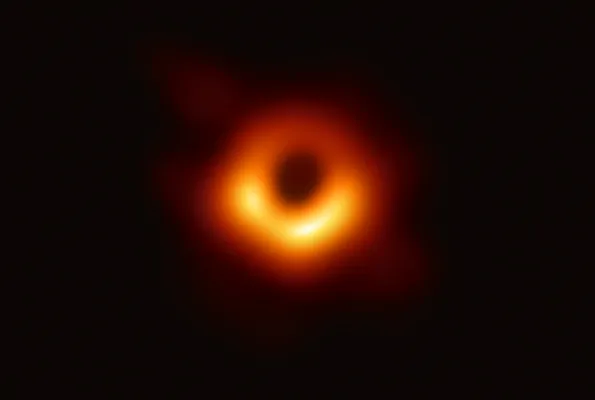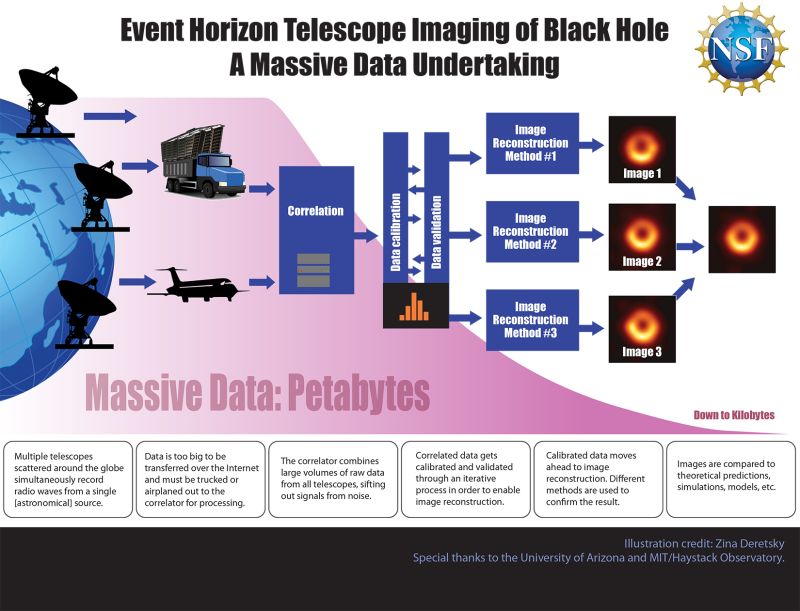
Downloading data from black holes
Last year the Event Horizon Telescope released the first image of a black hole. This stunning feat was decades in the making.
By Peter Kurczynski
NASA chief scientist for cosmic origins and former NSF program director for advanced technologies and instrumentation
The fastest way to send the largest data files is not by the internet -- it is by truck. Driving palettes of hard drives down dusty mountain roads is the only way to deliver the largest files of data from the remote observatories that take them to the computers that crunch them.
Buried within the precious cargo of ones and zeros from the observations of the Event Horizon Telescope are the hidden signatures of light from the edge of the universe – a black hole. On April 10, 2019, the team released the first-ever image of a black hole, which captivated the world. The technology to record these data was made possible by grants from the NSF going back nearly twenty years. How did we get here?
Back then, before smart phones existed and when computer hard drives were measured in kilobytes, visionary astronomers, for example, Event Horizon Telescope Founding Director Sheperd Doeleman, dreamed of combining observations from radio telescopes on different continents into a single Earth-sized array.
The idea was to point each telescope toward the same galaxy at the same time to capture an image of the black hole believed to lurk at its center. By itself, each telescope would be too weak, and all it would see is noise, extraneous data that would interfere with capturing a good image. The black hole would be there, but be too dim to see.
However, with an array of telescopes observing simultaneously and comparison of the data from each telescope after the fact, a computer could tease out an image of the black hole. The method might work in theory, but making it work in practice would demand the recording of data from the telescopes at bandwidths tens of thousands of times faster than ever before. No ordinary hard drive could transcribe this fire hose of data.
So astronomers at the Massachusetts Institute of Technology's Haystack Observatory, funded in part by the NSF Advanced Technologies and Instrumentation program, invented a solution. They developed a data recorder specially designed to keep pace with such high bandwidth telescope signals. The current Event Horizon Telescope records data at 64 gigabits per second. That is more than 1,000 times faster than a modern broadband internet connection and 90,000 times faster than early interferometers for astronomy developed 50 years ago.
Last year the Event Horizon Telescope released the first image of a black hole, a stunning feat decades in the making. As Doeleman later testified to Congress, NSF support was crucial. Without early funding for this technology behind astronomy, this observational tour-de-force could never have happened.
Since the times of Galileo and Kepler, astronomy has always been advanced by better observations. As is true of the telescope, technological advance has always enabled progress in science. A new study published in Journal of Astronomical Telescopes, Instruments, and Systems illustrates some of the many technologies that NSF has supported through the Advanced Technologies and Instrumentation program.
These technologies have included new methods for making telescopes and detectors, lasers that fire into the sky to correct for distortions caused by the atmosphere, and tabletop-sized antennas that listen in the desert for evidence of light from the first stars. The transformative impact of the support for the technology behind astronomy exemplifies the NSF motto: “where discoveries begin.”




